A Beginner’s Guide to Cable Machines
Author:
Reviewed by:
(Head of Sport Science, 20 years of Oly Lifting experience, PhD Sport Science)
Unlock your full potential by engaging with our experts and community! Have questions about your fitness journey or looking for expert advice on weightlifting techniques? Don’t hesitate — leave a comment below and Ihor Shymechko will provide a personalized answer and insights to help you reach your goals.
Torokhtiy is reader-supported. Some links are affiliate links, and we may earn a commission at no extra cost to you. See our disclosure page for details.
Say you’re completely new to the gym. You step in and bam – you’re completely overwhelmed with all th equipment and you have no idea where to start from. You remind may immediately go to the treadmill or a bike, but the cable machine is a lot more versatile than those two.
You can use it for all kinds of exercises that target almost every muscle group. We’ll walk you through everything you need to know about them, from understanding basic components to the benefits and attachments. You can use the cable machine to build strength, improve balance, or add variety to your routine, it’s a great place to start!
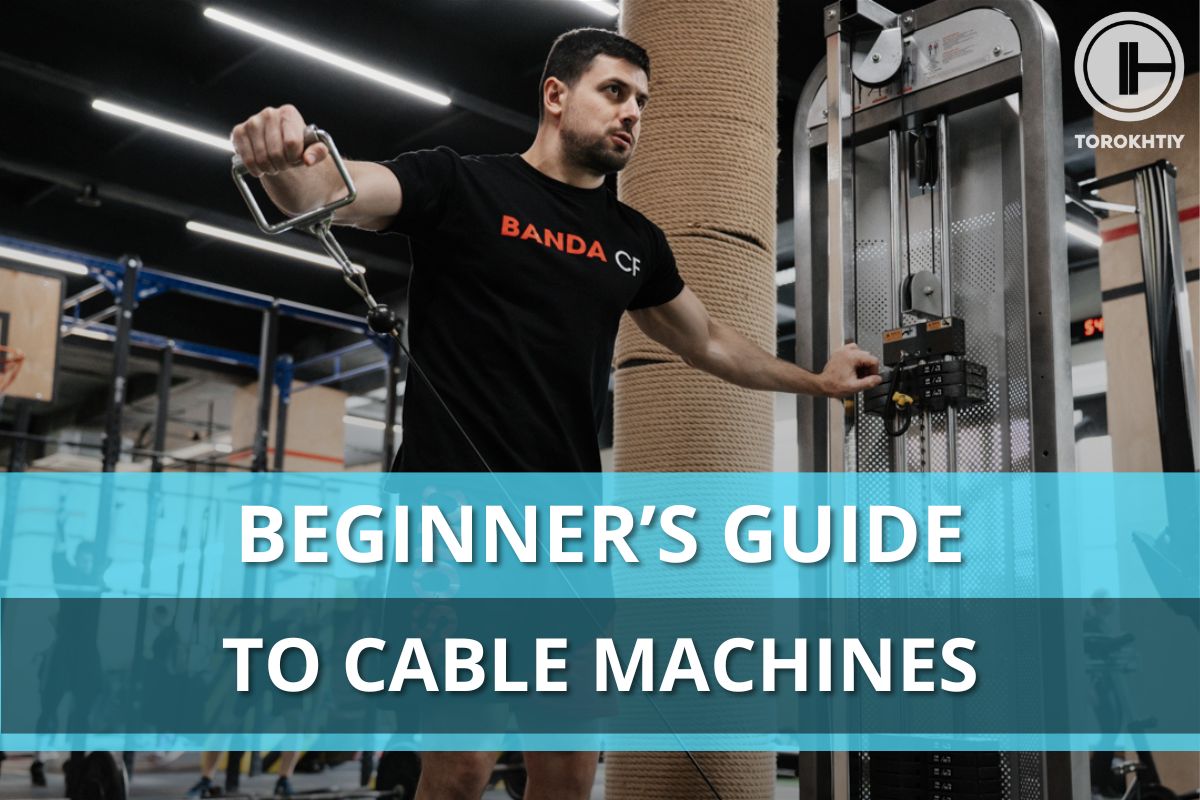
What Is A Cable Machine?
A cable machine is a bulky metal frame set with a pulley system and weighted plate stacks that move up and down with the help of the pulley/cable. It comes with multiple attachments or grips for performing various strength exercises that make it a highly versatile piece of equipment. You can find a trainer with a single pulley with a directional change without reducing the weight you lift, and a double pulley which cuts the weight in half.
Unlike with free weights, you can utilize a cable machine to train the whole body and perform different exercises by changing the resistance and attachments. It also provides additional control of your movements and brings constant pressure on muscles from the bottom to the top of each motion, by building strength capabilities and overall endurance.
A cable machine can be equipped with marked weight stacks that make it easy to control the load you work out with, or have plate loadable sleeves. Both options are effective and help you to track your progress. With a pin system, you just need to adjust the pin to the needed level to pump your muscles and improve your load capacity.
Besides keeping the upper and lower body tight while exercising, this equipment engages the core muscles too as the majority of exercises you perform in a standing position. So, you’ll activate your trunk for better stabilization and support. There’s no risk to drop the weight unlike when training with a barbell or dumbbells due to the weight stack and pulley system that control your movements throughout the rep with an opportunity to manage tension level.
5 Benefits Of Cable Machine Usage
This versatile gym equipment can be underestimated thanks to the numerous perks you’ll get by training on it. Despite the fact that it may take some time to get used to it, especially for beginners, once you know the purpose of each attachment and the construction overally, you’ll prefer working out on this full-body trainer instead of using a barbell, kettlebell, or other equipment to target specific muscle group separately. Let’s highlight the key benefits of a cable machine you’ll get from using it correctly.
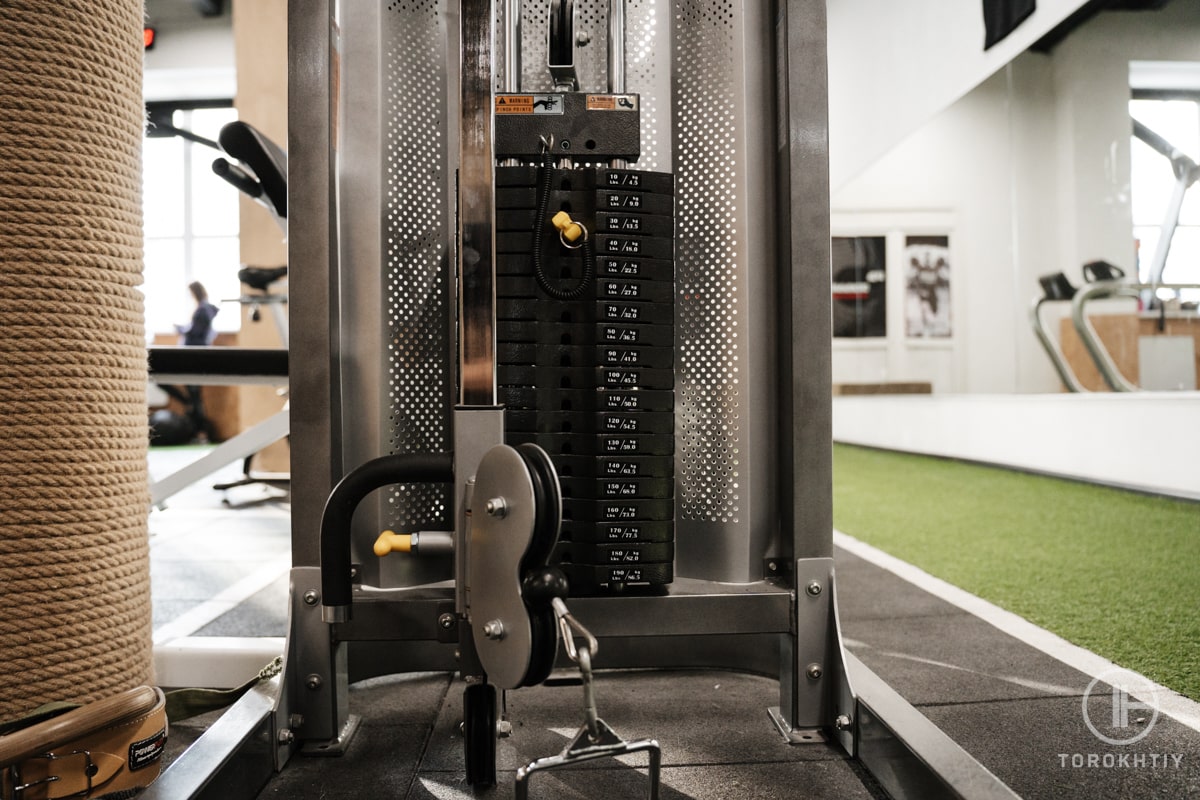
✅ Unlimited Range Of Motion
This machine brings you an opportunity to perform exercises in those ranges of movement that are more comfortable for you. It won’t limit your maximum power to perform each exercise with the maximum possible reps, but will enhance your strength and muscle mass build. You get the freedom to move as you want, without a fixed path of exercise motion.
✅ Isolating Specific Muscles
Due to the standing position, you can activate your core muscles including the abdominals, lower back, hips, and obliques to isolate the targeted muscle that you are training. Working out more muscles at the same time can result in challenging your body and gaining better performance and results.
For example, let’s look at the standing cable back row exercise: it targets the core, the upper back muscles mainly such as deltoids, traps, and rhomboids, with shoulders and arms (biceps and forearms), by engaging also other muscles such as the low back, abdominals, glutes, thighs, and calves.
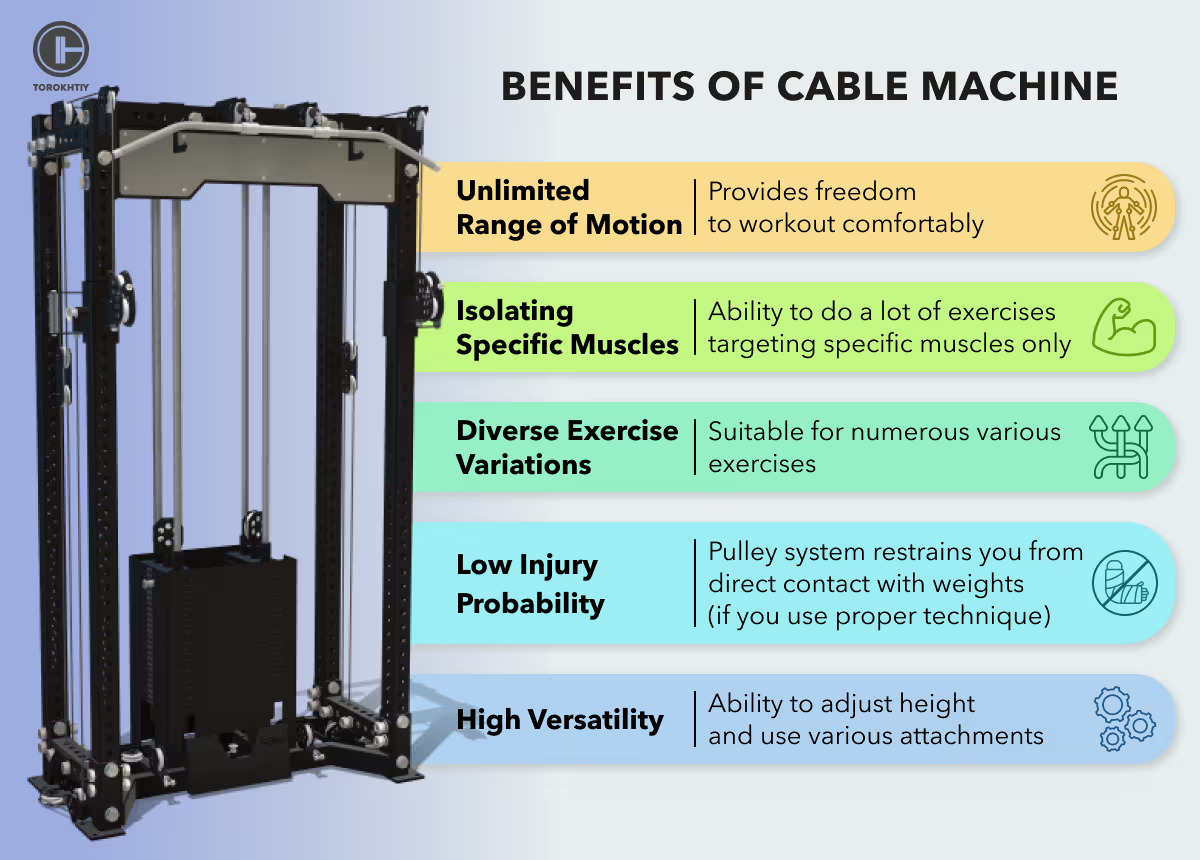
✅ Performing Diverse Exercise Variations
A cable machine is the perfect equipment for any type of functional training, so you can perform a wider range of exercises by managing the resistance level. Here are some exercises you can perform with the help of a cable machine.
1. For Upper Body:
- Standing cable shoulder press by using low to medium-height cables with handles to target middle and posterior deltoids.
- Cable chest fly to strengthen chest muscles that is also a good alternative to the bench press exercise.
2. For Abdominals:
- Cable wood chopper to enhance your core strength and improve spine flexibility.
- Cable standing crunch to work out your rectus abdominis muscles.
- Cable twists to target your core totally and obliques, by engaging hips and legs.
3. For Lower Body:
- Cable glute kickbacks to shape and strengthen the gluteus maximus muscles by focusing the resistance better than squats.
- Cable Romanian deadlift to train hamstrings, back, and glute muscles.
Also, a cable machine is helpful in overcoming a plateau in free weight training, because you can switch to training several parts of the body instead of targeting a specific muscle group.
✅ Low Probability To Get Injured
This machine is safe in usage: you’re more likely to get injury or strains when training with free weights or other conventional weight machines than when using a cable cross-trainer. That’s due to the pulley system that restrains you from direct contact with weights since you pull the cable. You don’t push and pull against the gravity force, so you get less tension on your ligaments. Also, it’s a good variant for people who recover from injuries.
✅ High Versatility
Cable machines are very versatile: you can change the starting height for any exercise using multiple attachments, including a rope, v-handle (known as a double-D handle), straight-bar, and single-handle (known as a split-handle). Such a variety enables you to try different grip options which challenge your hands and forearms in different ways to strengthen and build muscles.
For instance, with a narrow grip, you’ll be able to build the lats that are the large back muscles; with a wide grip, you’ll focus on the upper back muscles (namely rhomboids and trapezius) and arm muscles.
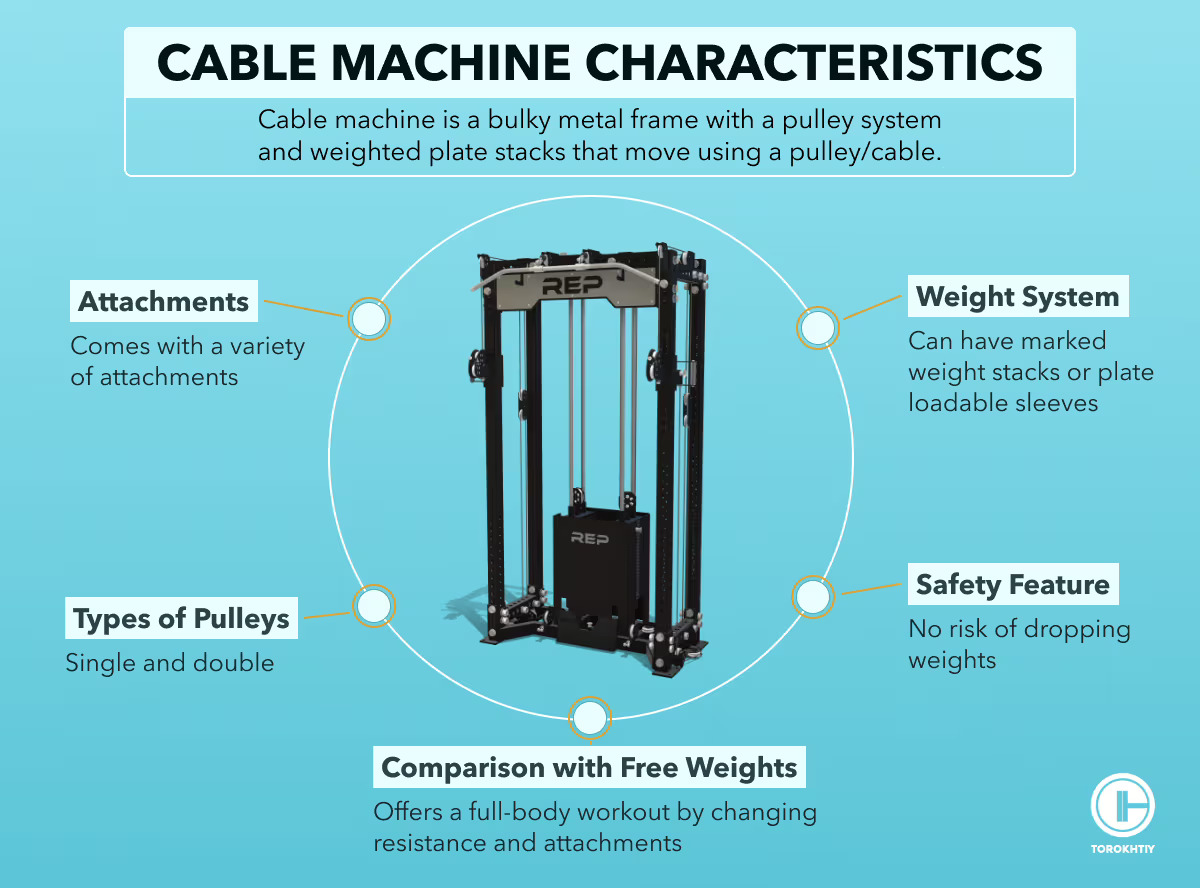
How To Choose A Cable Machine?
Considering the fact that cable machines are becoming more and more popular even among gym enthusiasts who are just taking up functional and strength training, the first thing they should know is to outline which key features of this functional trainer matter to them most. But, if you see this equipment for the first time or have already tried it several times at the gym, and still can’t define what plays a significant role in choosing the best home gym cable machine, then the following points.
Our expert Jacek Szymanowski have multiple personal recommendations for you as well:
“If you’re looking to save some space and already got some plates, check titan fitness. They have basic ones that are really affordable and surprisingly won’t take much space. If you’re building a gym in the garage check what ROGUE has to offer – they really got your back. You can modify their squat rack to cable machine with extra bucks. My opinion – Can’t go wrong with Rogue.”
1. Weight Resistance System
When picking up a cable machine for your home gym, think well about what weight resistance system you prefer most – a weight plate-loaded or pin-adjustable one. The first option offers you to load the machine with plates of different weights. However, it can require more space because of the plates you need to store somewhere.
The second means that to change a weight resistance you need to move a pin up or down the weight stack. Generally, machines with pin load are easy to use and you can adjust the needed weight quickly. Such functional trainers come with weight stacks (single or double) that vouch for small footprints, but the machine weight can be quite bulky.
Our expert Sergiy Putsov gave his tips for choosing as well:
“I recommend investing in a compact, but versatile cable machine for your home gym, like the one on the top pick from REP. It’s great for targeting various muscle groups and offers a wide range of exercises for a total body workout.”
It’s difficult to say what type is better, although, with a pin system, there’s no need to take additional weight and switch heavy plates manually. All you need to do is to take a pin and insert it in a proper hole on the weight stack which also brings more weight increment.
2. Construction Design
You can find cable machines with pulley systems with a single-weight stack which limits the range of exercises and reduces the user capacity to one. A dual-stack design enables more full-body exercises. The dual-weight stack can be located on either side of the machine or at its back. The main difference is the availability of storage shelves where you can store the attachments, but it’s more of a user preference.
Tips From the Champ
When choosing cable machines for your home gym, to prioritize build quality and an effortless pulley system. These two (especially the second) are often overlooked and underrated. You want a smooth cable glide, which will provide consistent resistance while exercising. The build quality will ensure product longevity. It is always a great long-term strategy to ensure the maximum mileage of a cable machine, without sacrificing the quality of the pulley system. Other than that, look for comfy handles, and a reliable locking system for the weight stacks.
Olympic Weightlifting Champion
3. Attachment Variety
As usual, a high-quality cable machine is equipped with numerous attachments that add variety to the training and can challenge your body with different intensities, angles, and range of motion. You can find the following accessories that will target diverse muscles: single grip handle strap, tricep rope, straight bar, curl bar, row handles, lat bar, narrow pulldown bar, V-bar, etc.
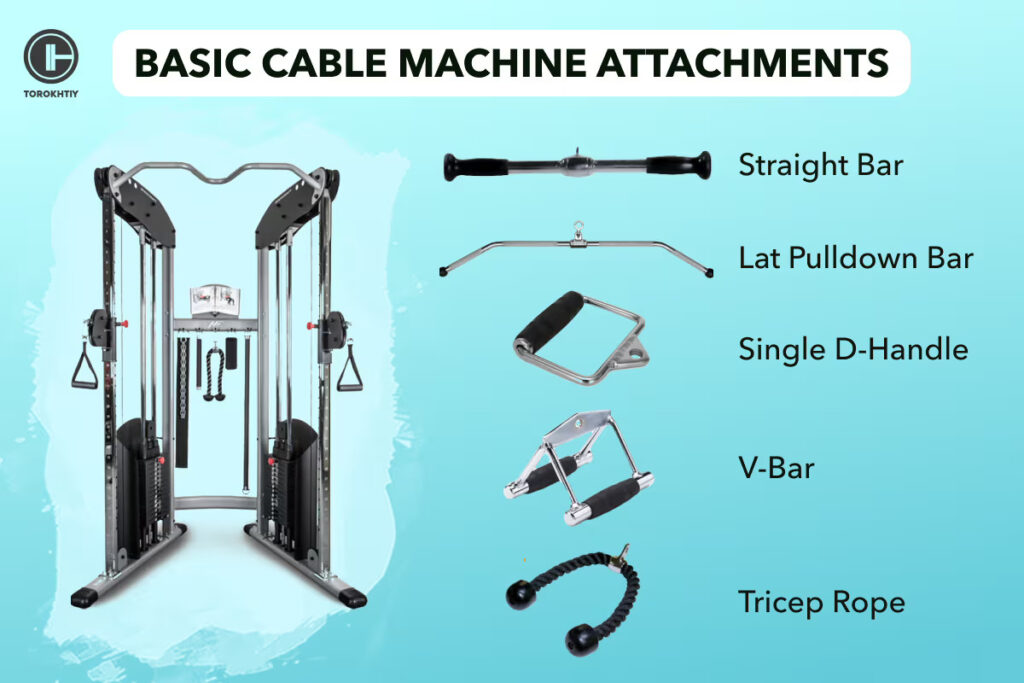
4. Adjustability
Before buying a cable machine, you should check its adjustability to be able to use it in many ways. To change the intensity of the training, you can manage cable weight and height. The more functional a trainer is, the better quality of your workout will be. By changing the height of the pulley, you’ll be able to work out different muscle groups and vouch for better comfort during the workout.
| Key Feature | Description | Consideration Points |
|---|---|---|
| Weight Resistance System | Weight plate-loaded or pin-adjustable resistance | Weight-plate loaded needs storage space for plates. Pin-adjustable systems are user-friendly and quick to adjust |
| Construction Design | Single-weight stack or dual-stack design | Single-stack limits workout variety. Dual-stack can support more exercises and can have storage shelves |
| Attachment Variety | High-quality machines come with a variety of attachments | Look for attachments like single grip handle strap, tricep rope, straight bar, curl bar, row handles, etc. Attachments let you target the same muscle group in different ways |
| Adjustability | Make sure the machine is adjustable in terms of cable height to cater to different workouts and comfort | More adjustability means more workout variety |
REP Fitness FT-3000 Compact Functional Trainer 2.0
- Item Dimensions: 34” L x 52” W (front)/ 23” W (rear) x 78” H
- Item Weight: 770 lb
- Weight Stack: 187 lb (each stack)
- Max Resistance Weight: 93.5 lb
- Footprint: 34″ X 52″
- Cable Travel Length: 76.3”
- Warranty: limited lifetime warranty
- Additional Features: 21 cable positions, 2 D-handles, storage pegs, placard
- Min/Max Usable Weight Per Side: 10-90 lb
- Positions & Cable Range: 21
Our recommendation is a compact functional FT-3000 model of the cable machine from REP Fitness. It provides 21 cable positions and comes with two weight stacks, each of 187 lbs maximum resistance weight. It comes with a 2:1 ratio meaning 100 lbs feels like 50 lbs, so overall you get 374 lbs that feel like 187 lbs. You can adjust the weight with the help of a magnetic-tipped pin and an additional pin to secure the trolley.
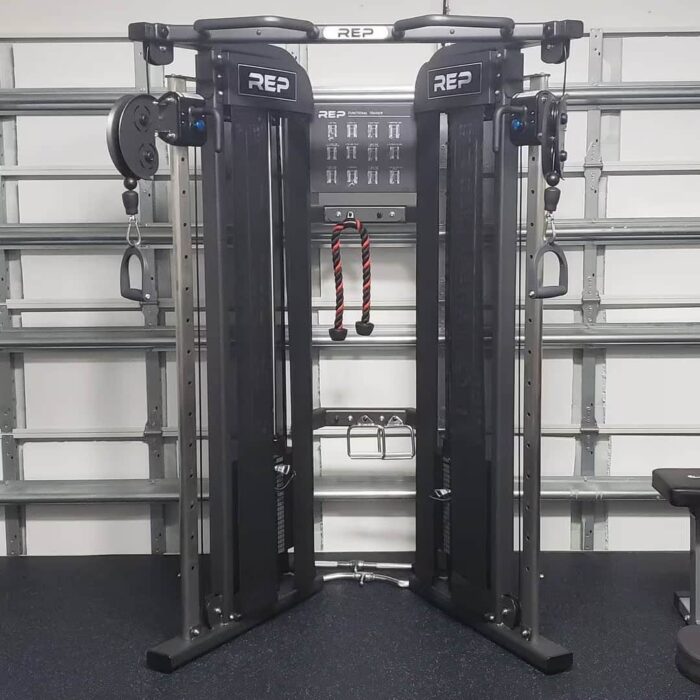
The frame is stable and durable, double-coated with a chip-resistant, electrostatic powder coating, with a matte black finish. The cables are equipped with aluminum pulleys. It includes two polymer D-handles, pegs for attachment storage, four additional 2.75 lb incremental weights enabling you to make smaller weight changes, and also a placard with different cable exercises.
The cable machine has 93.5 lb of the maximum usable weight per side, with the minimum usable weight of 10 lb, while the height is 78”.
How To Adjust A Cable Machine?
As you get closer to this bulky training machine, it’ll be super easy to adjust it to your needs. You can start the adjustments by selecting a fitting weight load by putting a pin in a weight stack. The lower you put the pin, the heavier weight you’ll get.
Then, you can set the height of the adjustable pulley by placing it at the top, middle, and bottom of the pole depending on the exercise you plan to do. Slide it up and down along the tower. You need to find an adjustable lever that keeps the pulley locked in place. Press the lever up to release the lock. Then you can move the pulley up and down to the needed height. Hold the pulley with one hand to secure the lever back, so it won’t get loose.
For instance, to perform an overhead tricep extension you need to place the pulley on each side at the top of the machine, for cable knee-ups – in the top center, and to execute glute kickbacks – at the bottom of the pole.
It’s also possible to adjust the angle of the cable from the overhead to the lower position. Changing the angles provides diverse motion patterns with safe plane movements for multiple exercises:
- When attached to the above cable: tricep rope extension, lat pulldown, cable flys, etc.
- When attached to the lower cable: bicep cable curls, seated cable row, hip abductors, leg raises, etc.
Depending on the exercises you plan to do, choose a corresponding attachment you will secure to the carabiner located on the end of the pulley cable. If you want to do bench presses, you can place a bench between the pulleys, with the cable at the bottom, and choose a fitting weight by placing the pin at the specific hole on the weight stack.
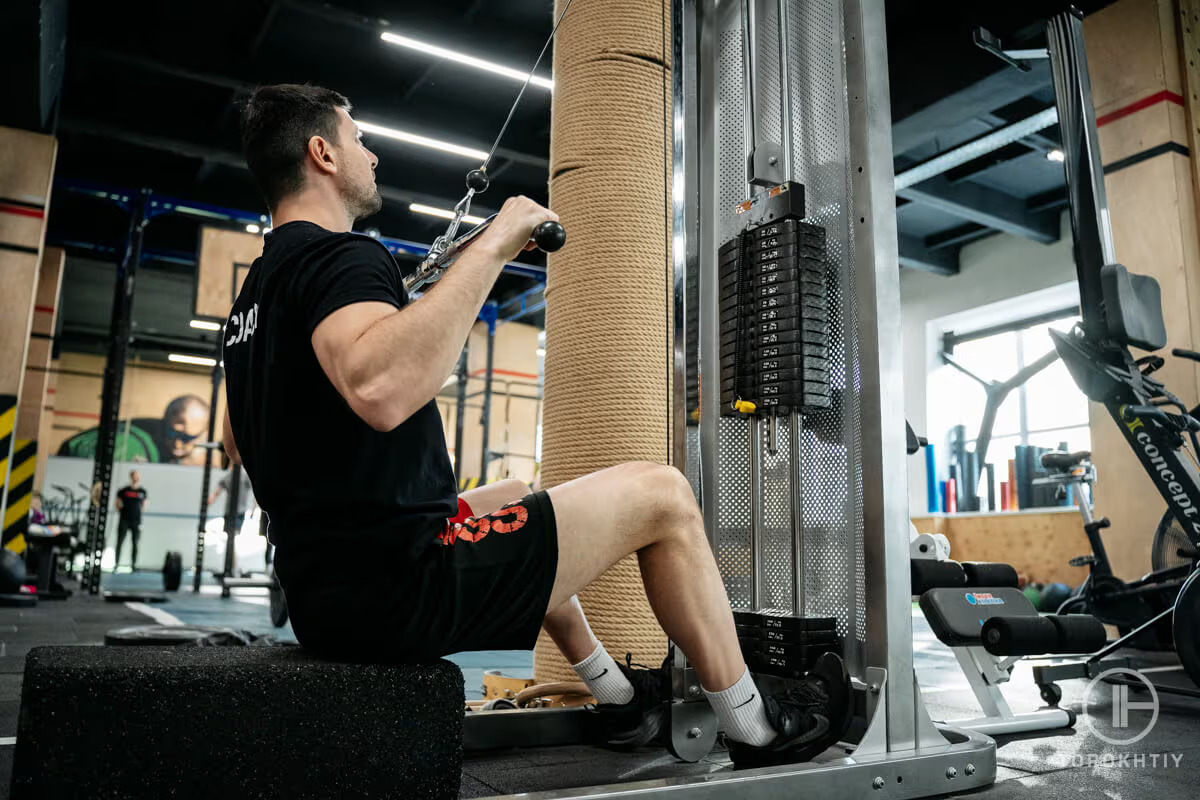
1. Choose Your Exercise
First, choose the exercise you want to do because different exercises need different pulley positions (whether at the top, center or the bottom of the machine).
If you’re unsure about the pulley position for a particular exercise, consult a trainer because proper setup is important for your workout to be effective.
2. Adjust the Machine
Next, what you want to do is adjust the machine according to the chosen exercise. Modify the height by sliding the pulley up and down along the tower until you find a height that works best.
Then, choose the appropriate handle (this depends on the exercise you want to do). After you’ve chosen the handle, attach it to the carabiner that’s at the end of the pulley cable.
Now, find the adjustable lever that locks the pulley and push it to release the lock (this allows adjustments to be made). After setting the pulley to the height that works for you, hold it with one hand while securing the lever to prevent any unwanted movement.
If you want to do exercises like bench presses, position a bench between the pulleys and adjust the cable to the bottom position.
3. Choose Your Weight
Choose the amount of weight you want to lift and insert the pin at the chosen weight level. Remember that lower positions usually represent heavier weights and higher positions indicate lighter ones.
Now you’re done with adjustments and you’re ready to start your workout!
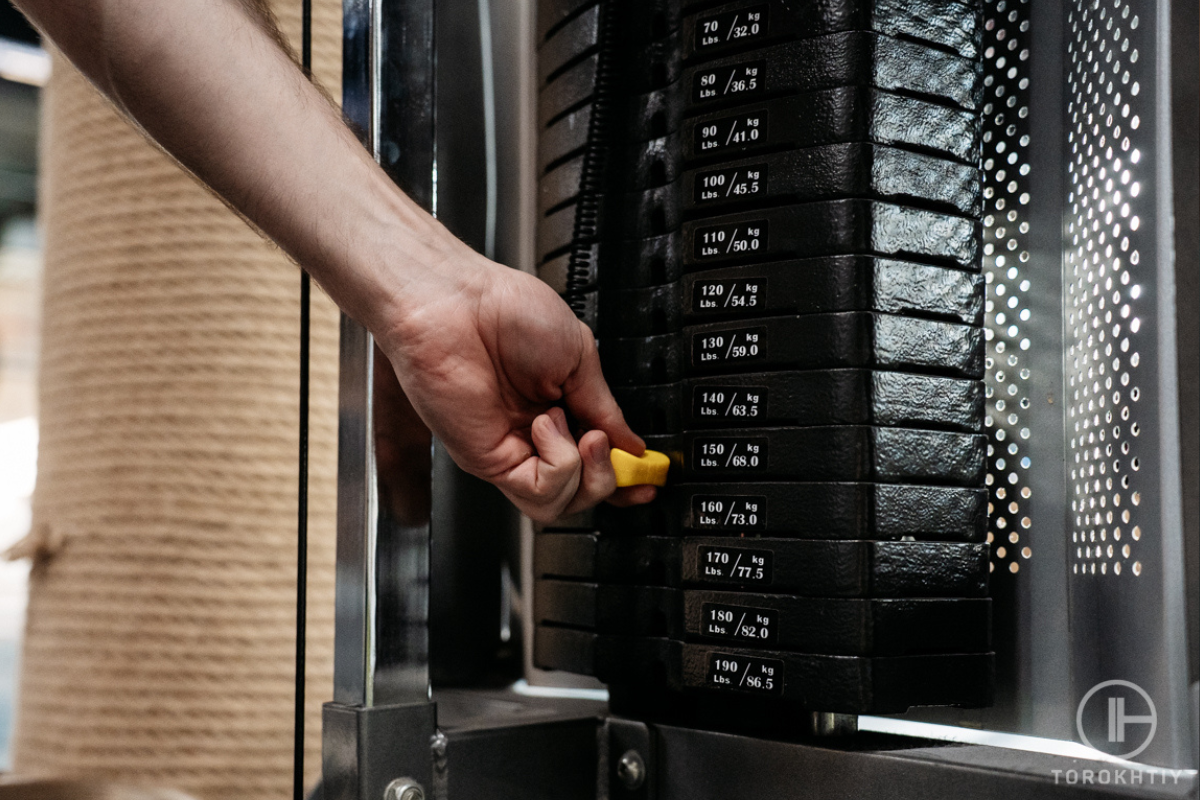
7 Cable Machine Attachment Types
We’ve already established how incredibly versatile cable machines are, and part of that versatility comes from the wide range of attachments.
These attachments allow you to target different muscle groups and do a lot of different exercises with precision and control.
Let’s see which attachments you can choose from and what you can use them for.
1. Straight Bar
This is a solid, rigid bar that gives a stable grip and distributes the force evenly.
Used for:
- Lat pulldowns
- Tricep pushdowns
- Upright rows
- Bicep curls
- Overhead tricep extensions
- Seated rows
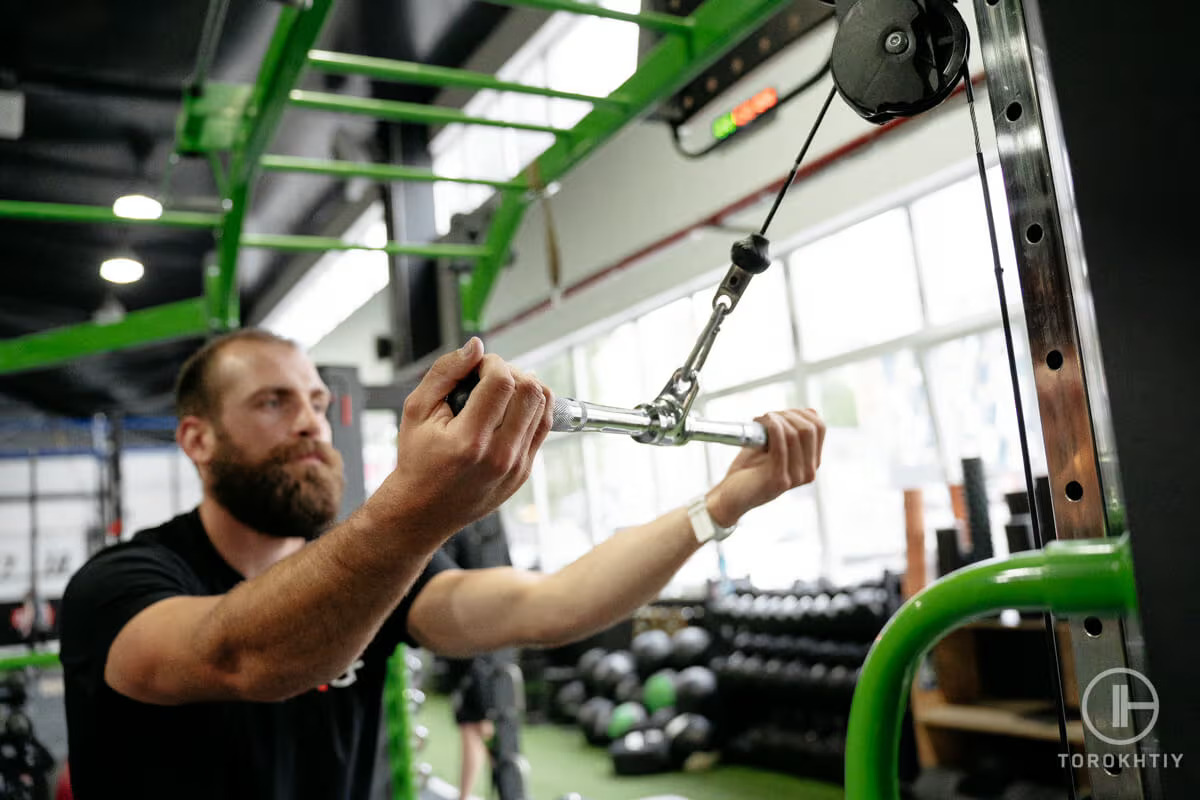
2. Tricep Rope
It’s designed to isolate the triceps with a flexible rope. The tricep rope reduces wrist strain and gives a comfortable grip.
Used for:
- Tricep extensions
- Rope hammer curls
- Face pulls
- Overhead tricep extensions
- Rope crunches
- Standing rope curls
- Front raises
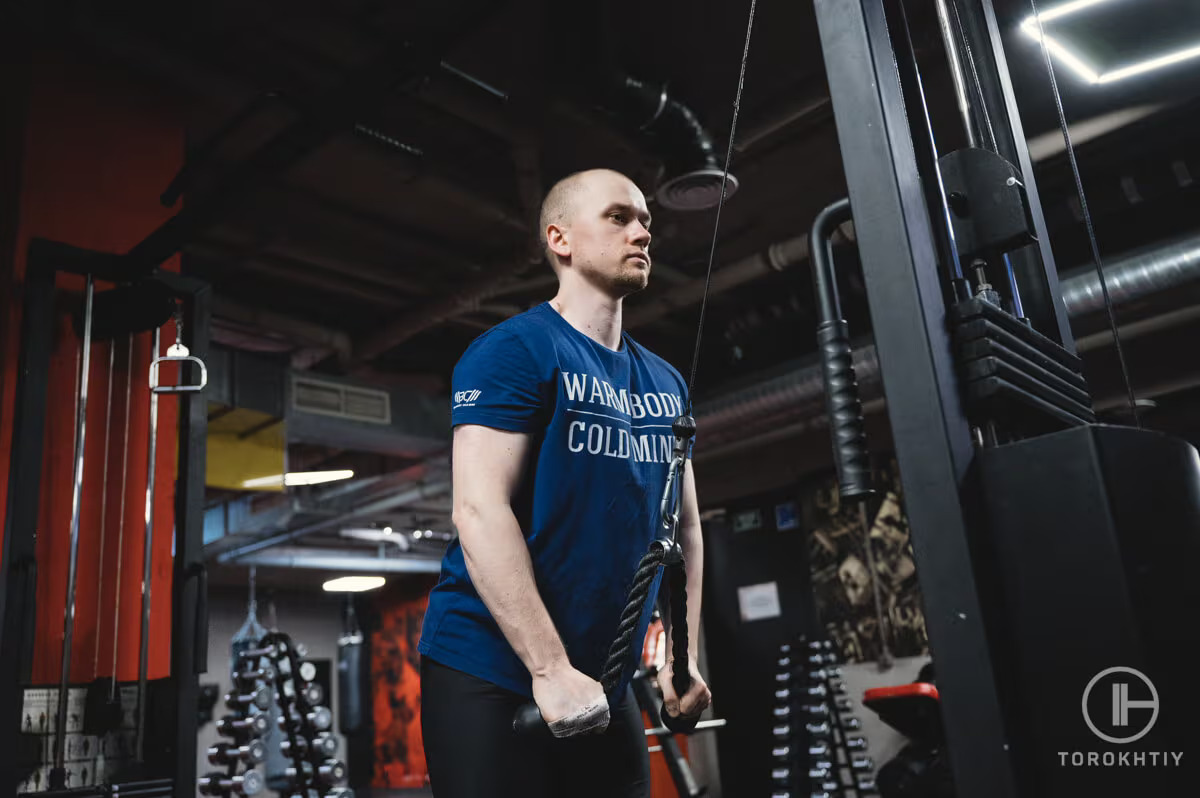
3. Single D-Handle
This is a super versatile attachment designed for single-arm exercises.
Used for:
- Single-arm cable curls
- Single-arm rows
- Single-arm chest press
- Single-arm tricep pushdowns
- Single-arm lateral raises
- Single-arm cable cross
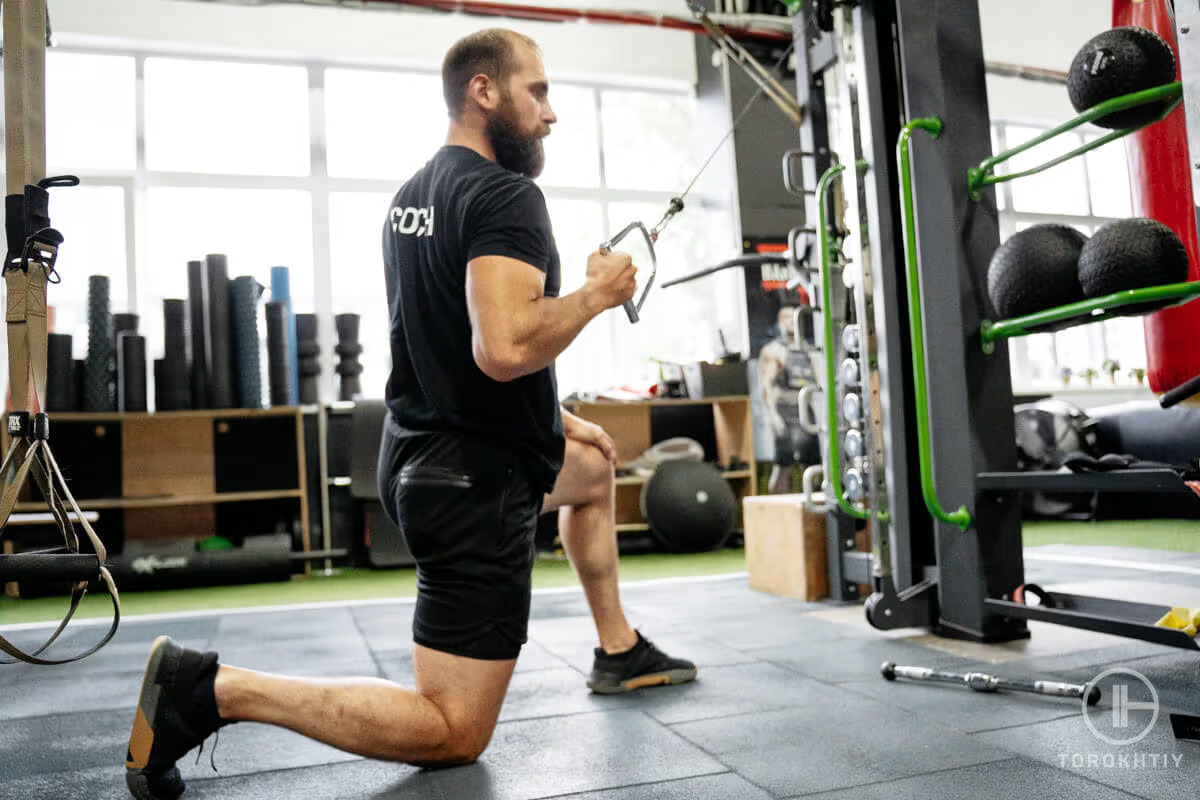
4. V-Bar
The V-Bar is designed with multiple grip positions and is ideal for targeting biceps, triceps and back muscles while also ensuring wrist comfort.
Used for:
- Upright rows with V-bar
- Close-grip face pulls
- Seated V-bar rows
- V-bar bicep curls
- V-bar rows
- V-bar tricep pushdowns
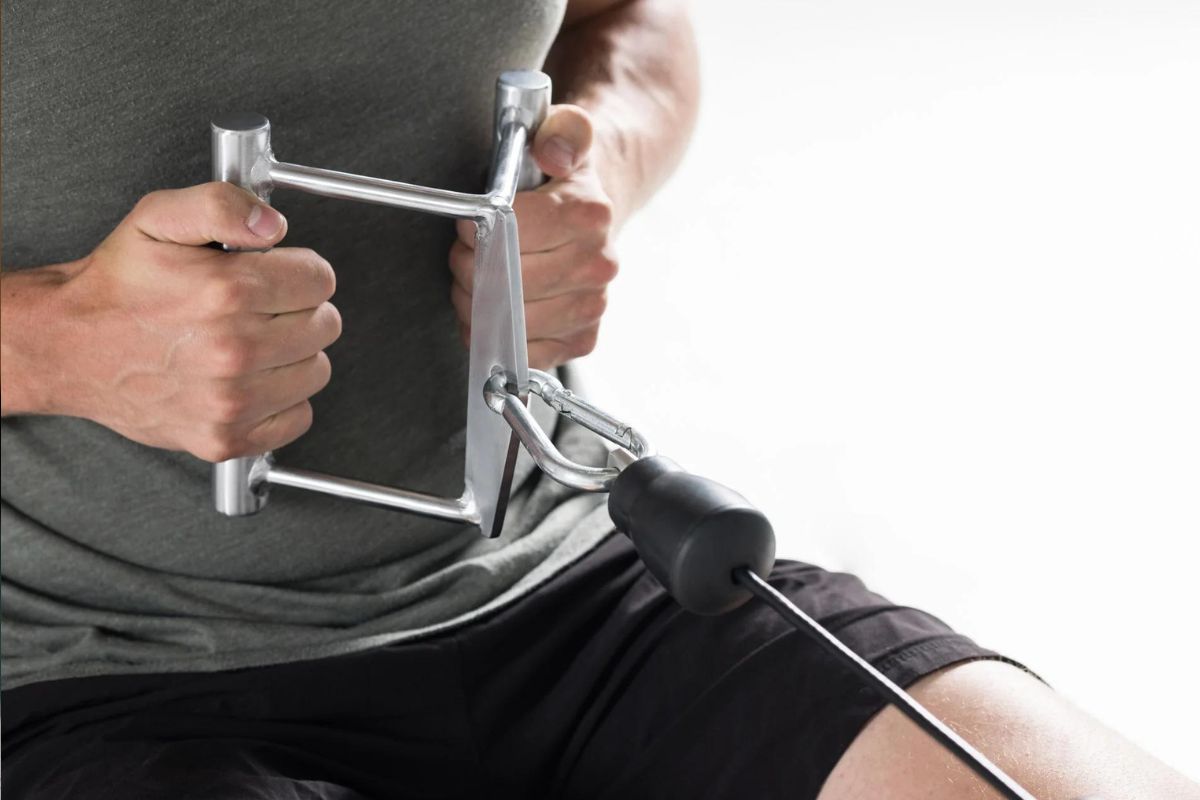
5. Ankle Strap
This is absolutely essential for workouts that focus on your legs and glutes. It secures around your ankle and provides support and stability.
Used for:
- Cable kickbacks
- Leg raises
- Hip abductions
- Hip adductions
- Cable leg curls
- Front leg raises
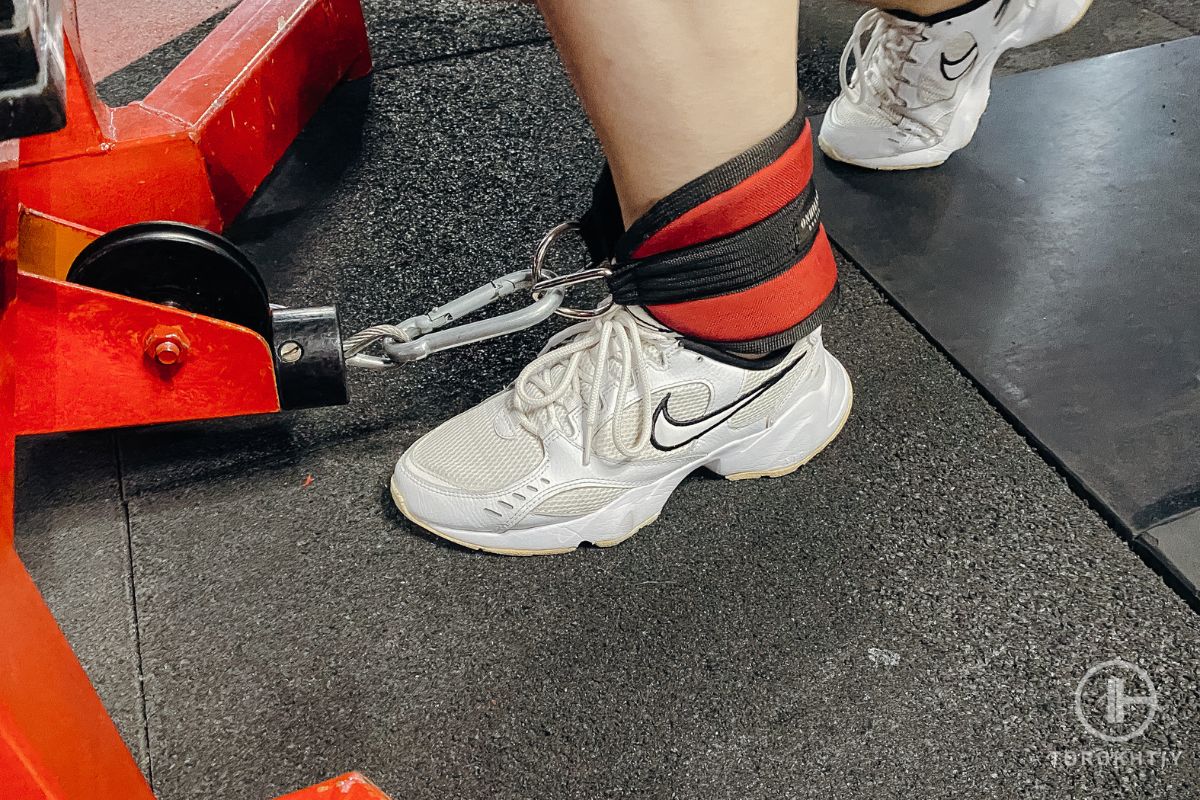
6. Stirrup Handle
The stirrup handle offers a neutral grip that’s good for a lot of different workouts.
Used for:
- Cable curls
- Lateral raises
- Stirrup handle rows
- Crossbody curls
- Standing chest press
- Front raises with stirrup
- Stirrup handle pushdowns
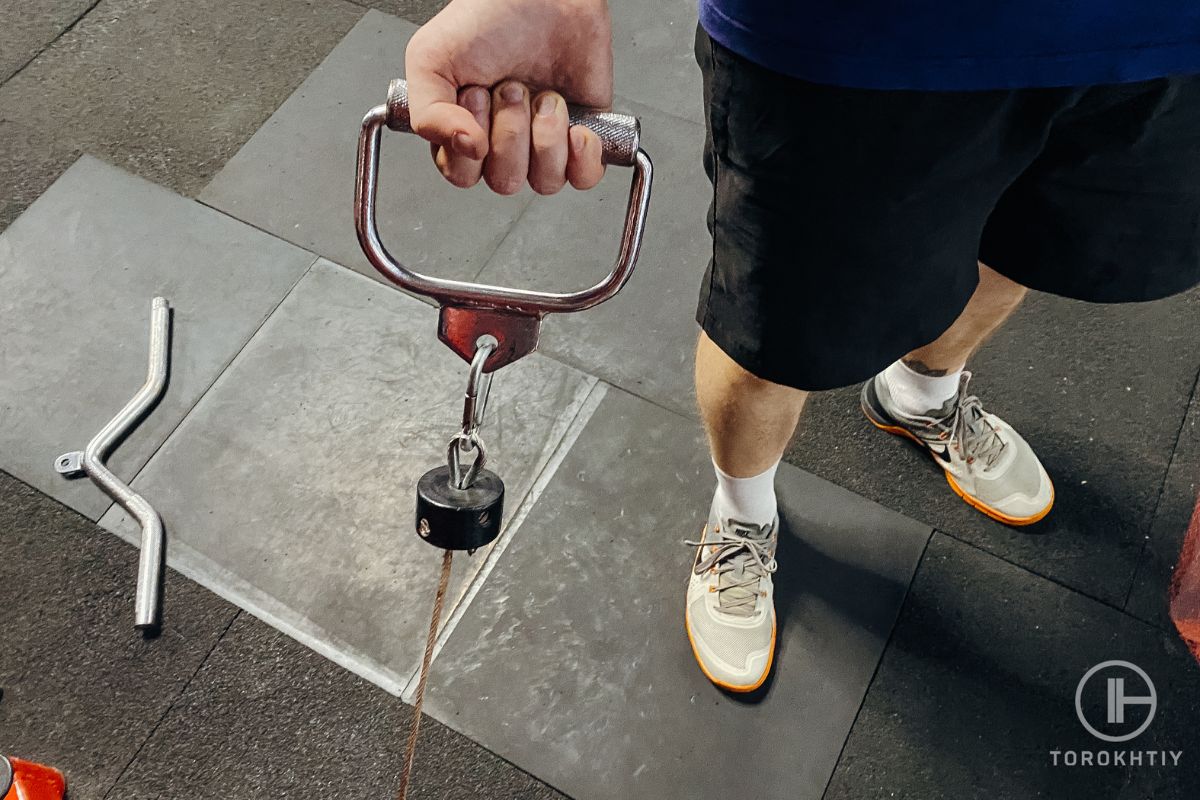
7. Crossover Handle
This is ideal for chest and upper body exercises and gives a broad range of motion.
Used for:
- Cable crossovers
- Decline cable cross
- Incline cable cross
- Standing flys with crossover
- Crossover tricep extensions
- Crossover bicep curls
- Cable shrugs
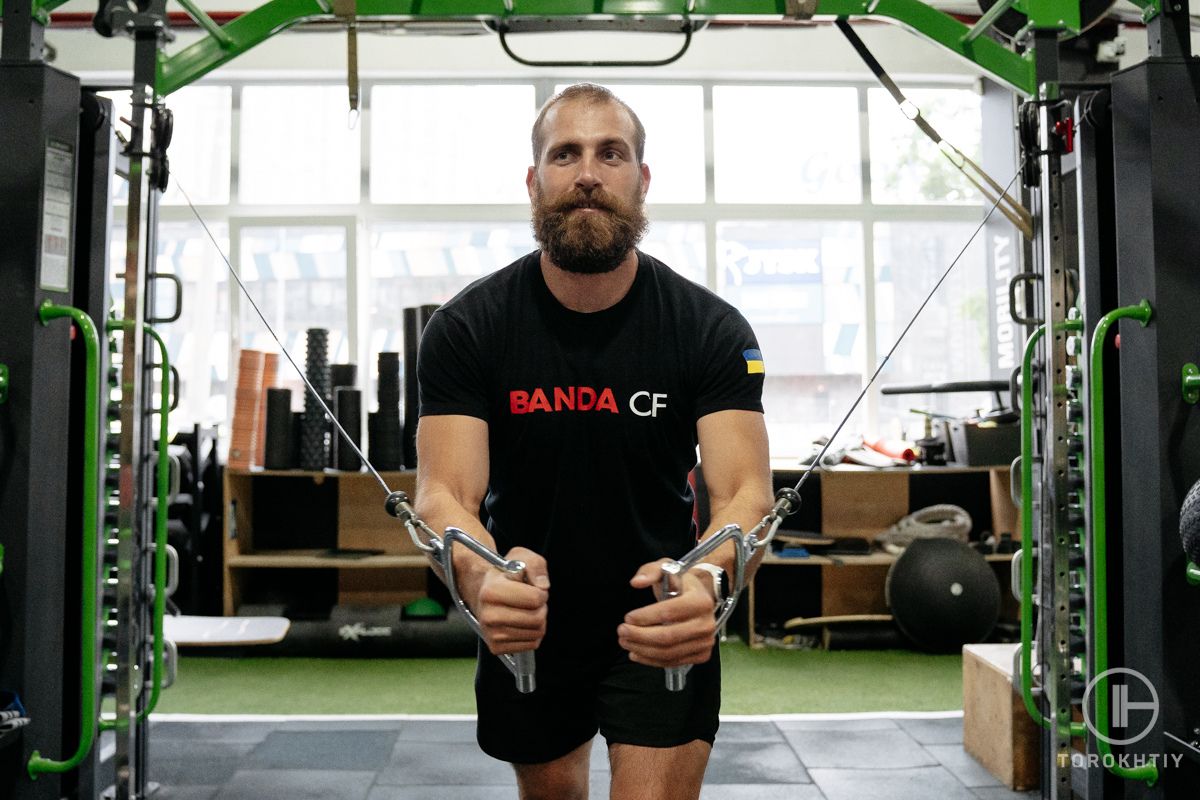
Multi-Attachment System
If you do any research on cable machines, you’ll notice that some of them offer a multi-attachment system, which allows you to quickly switch between various handles and grips. This system adds a ton of flexibility to your workouts and makes for a very seamless workout experience.
1. Close-Grip
This is designed for a more compact grip, it enhances muscle engagement in focused exercises.
Used for:
- Close-grip lat pulldowns
- Close-grip cable curls
- Close-grip seated rows
- Close-grip tricep pushdowns
- Close-grip cable chest press
- Close-grip upright rows
- Close-grip shoulder press
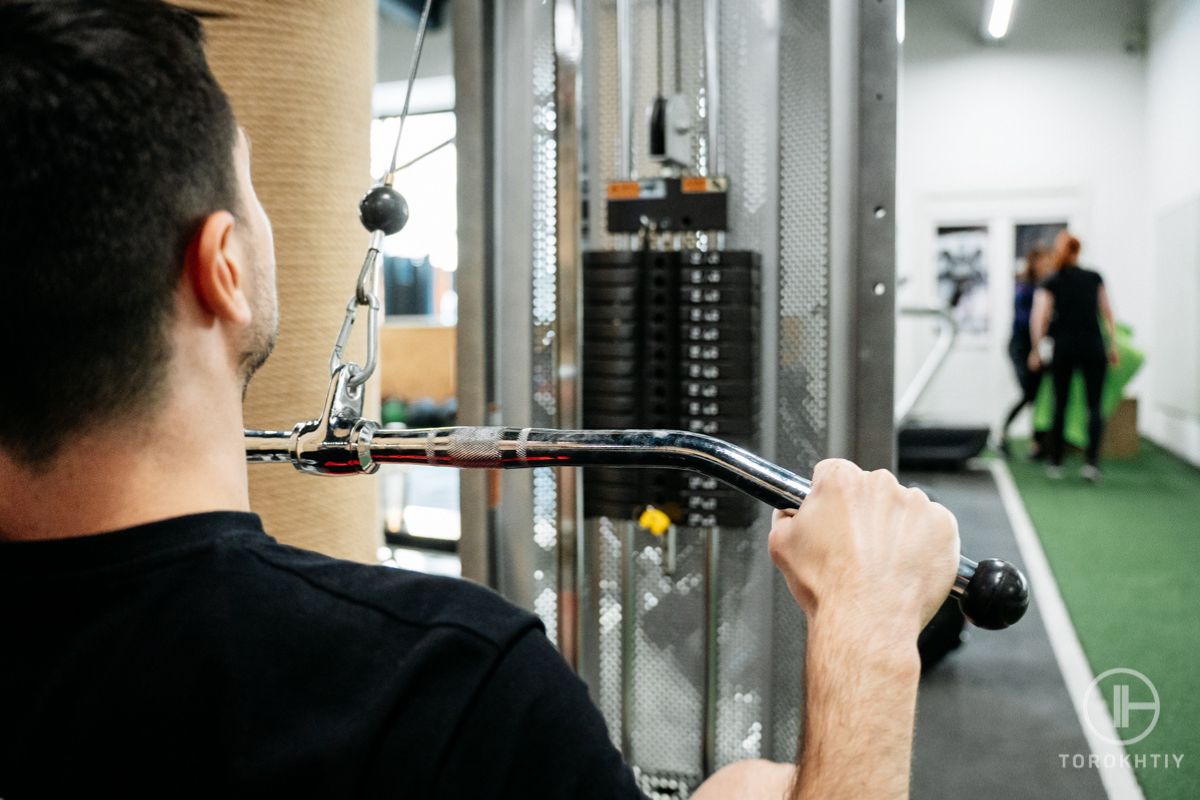
5 Top Popular Cable Machine Exercises
If you ask someone “What workouts are cable machines good for?”, prepare for a long answer. One thing about cable machines everybody knows about is that they’re super versatile and allow for more movement. But still, with all the workouts you can do, there are some that are absolute staples.
1. Lat Pulldown
The first one is the lat pulldown – it’s a cornerstone for developing back and shoulder strength.
2. Cable Row
To complement it, the cable row will do a great job at targeting the upper back and lats, which contributes to better posture and improved pulling strength.
3. Cable Flys
For chest-focused workouts, cable flys are an excellent way to isolate your pecs.
4. Arm Development
Tricep pushdowns and bicep curls are excellent for arm development because they give constant tension throughout each rep and help define your muscles.
5. Lower Body
Cable machines aren’t limited to your upper body; they’re just as good for your lower body. Cable squats, for example, are a very dynamic leg workout that targets your quads, hamstrings and glutes. Leg raises and kickbacks are also fantastic leg workouts that target specific muscle groups, like quads and glutes.
If you want to go beyond standard workouts, you also have an opportunity to use a cable machine for functional movements, like wood chops and standing rotations, which engage the core and help with overall stability.
FAQ
Can I Build Muscle Just With A Cable Machine?
Yes, you can build muscle mass by training on a cable machine since it provides continuous tension during the whole range of motion and can incorporate almost all muscles while working out the specific muscle group.
You can adjust the height and angle to exercise with different resistance levels and target diverse muscles. This makes a cable machine perfect to pump up muscles via performing compound and isolation exercises.
Why Cable Machines Are Better Than Free Weights?
Cable machines are highly versatile by offering numerous attachments you can choose from to train diverse muscles simultaneously. Also, this equipment is more suitable for beginners because it brings less probability of injuries due to the possibility to adjust the weight with the help of a pin system and has no direct contact with weight thanks to the available pulley mechanism.
Is A Cable Machine A Good Workout?
Yes, a cable machine offers multiple exercise options to activate the whole body with the possibility to isolate particular muscles. A cable trainer will fit athletes, beginners or those who get used to training alone since it works muscles in a controlled way. This equipment can help to build up a proper form and technique by making a novice move in a certain way to learn correct movements and their trajectory.
How Much Does A Good Cable Machine Cost?
The price can range from about $1,000 to $3,000 or more, depending on the brand, features and the accessories that are included in the package. Before deciding to spend money on a specific cable machine, make sure you keep your needs and budget in mind because a crazy expensive machine may be unnecessary, especially for basic workouts and home use.
Conclusion
The cable machine can open up world possibilities, especially for beginners. It has an ability to target multiple muscle groups and offer a variety of exercises, so there’s no way you won’t benefit from including it into your routine.
Get familiar with its components, learn the basic exercises, and once you choose the attachments, you’re good to go and start working out! Practice makes perfect so if the beginning is awkward – that’s fine, just keep at it and the more you use it, the more comfortable you’ll become.
If there’s anything we haven’t covered – let us know in the comment section! We’d love to hear your thoughts and opinions.
Experts Who Contributed To This Article
20 years of Oly Lifting & Training experience
26 years of Oly Lifting & Training experience
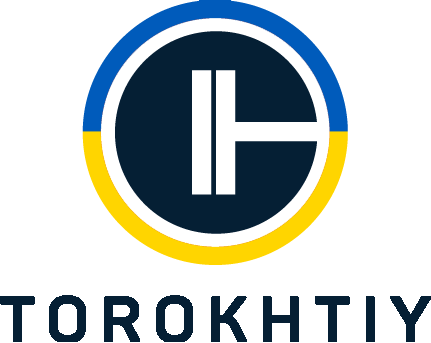
Also read:
- Ultimate Lat Pulldown Machine Guide
- All In One Home Gym Buying Guide
- Seated vs Standing Calf Raise
- Ultimate Ab Machine Guide
- Roman Chair Exercises
- Balance Board Exercises
- Sandbag Workout
- Ghd Sit Up
References:
- Functional strength training // ScienceDirect: https://www.sciencedirect.com/science/article/abs/pii/S0531556516301735
- Differences in Muscle Activity During Cable Resistance Training Are Influenced by Variations in Handle Types // LWW: https://journals.lww.com/nsca-jscr/Fulltext/2016/07000.aspx
- Progressive overload without progressing load? // NCBI: https://pubmed.ncbi.nlm.nih.gov/36199287/
- A Novel Method for Assessing Muscle Power During the Standing Cable Wood Chop Exercise // LWW: https://journals.lww.com/nsca-jscr/Fulltext/2017/08000.aspx
- Optimal loads for power in older men and women using plate-loaded resistance machines // ScienceDirect: https://www.sciencedirect.com/science/article/abs/pii/S0531556519301780
- Effects of Grip Width on Muscle Strength and Activation in the Lat Pull-Down // LWW: https://journals.lww.com/nsca-jscr/Fulltext/2014/04000/Effects_of_Grip_Width_on_Muscle_Strength_and.35.aspx
- Joseph F Signorile, “Differences in Muscle Activation and Kinematics Between Cable-Based and Selectorized Weight Training” NCBI, https://pubmed.ncbi.nlm.nih.gov/28129277/ (2017 Feb)
- Ronald Snarr, “A Comparative Analysis and Technique of the Lat Pull-down” ResearchGate, https://www.researchgate.net/publication/282178642 (October 2015)
- Silvio Lorenzetti, “Pulling Exercises for Strength Training and Rehabilitation: Movements and Loading Conditions” MDPI, https://www.mdpi.com/2411-5142/2/3/33 (19 September 2017)
- “Build Strength and Enhance Your Workout with These Cable Exercises” HealthLine, https://www.healthline.com/health/exercise-fitness/cable-exercises
- Photos are made by Torokhtiy Media Team, by Rep Fitness.
Why Trust Us?
With over 20 years in Olympic weightlifting, strength training, nutrition coaching, and general fitness our team does its best to provide the audience with ultimate support and meet the needs and requirements of advanced athletes and professional lifters, as well as people who strive to open new opportunities and develop their physical capabilities with us.
By trusting the recommendations of our certified experts in coaching, nutrition, and sports training programming, as well as scientific consultants, and physiotherapists, we provide you with thorough, well-considered, and scientifically proven content. All the information given in the articles concerning workout programming, separate exercises, and athletic performance, in general, is based on verified data.
The product testing process is described in more detail here.
Author: Ihor Shymechko
Pro Olympic Weightlifter, Coach
Best Results: Snatch – 208 kg,
C&J – 240 kg
Ihor has been a professional weightlifter since 1996, boasting over two decades of competition experience. His notable achievements include clinching the European Championship in 2009 and securing a silver medal in the 105kg division at the Senior World Championships in 2011. Ihor represented his country in the 2008, 2012, and 2016 Summer Olympics. After retiring from competitive weightlifting, he transitioned to coaching, leveraging his vast experience to guide athletes who now compete on both national and international stages.
Reviewed by: Sergii Putsov
Head of Sport Science, PhD
Best Results: Snatch – 165 kg,
C&J – 200 kg
Sergii Putsov, Ph.D., is a former professional weightlifter and National team member, achieving multiple medals in the 94 kg weight category at national competitions. With a Master’s degree in “Olympic & Professional Sport Training” and a Sport Science Ph.D. from the International Olympic Academy, Greece, Sergii now leads as the Head of Sport Science. He specializes in designing training programs, writing insightful blog articles, providing live commentary at international weightlifting events, and conducting educational seminars worldwide alongside Olympic weightlifting expert Oleksiy Torokhtiy.





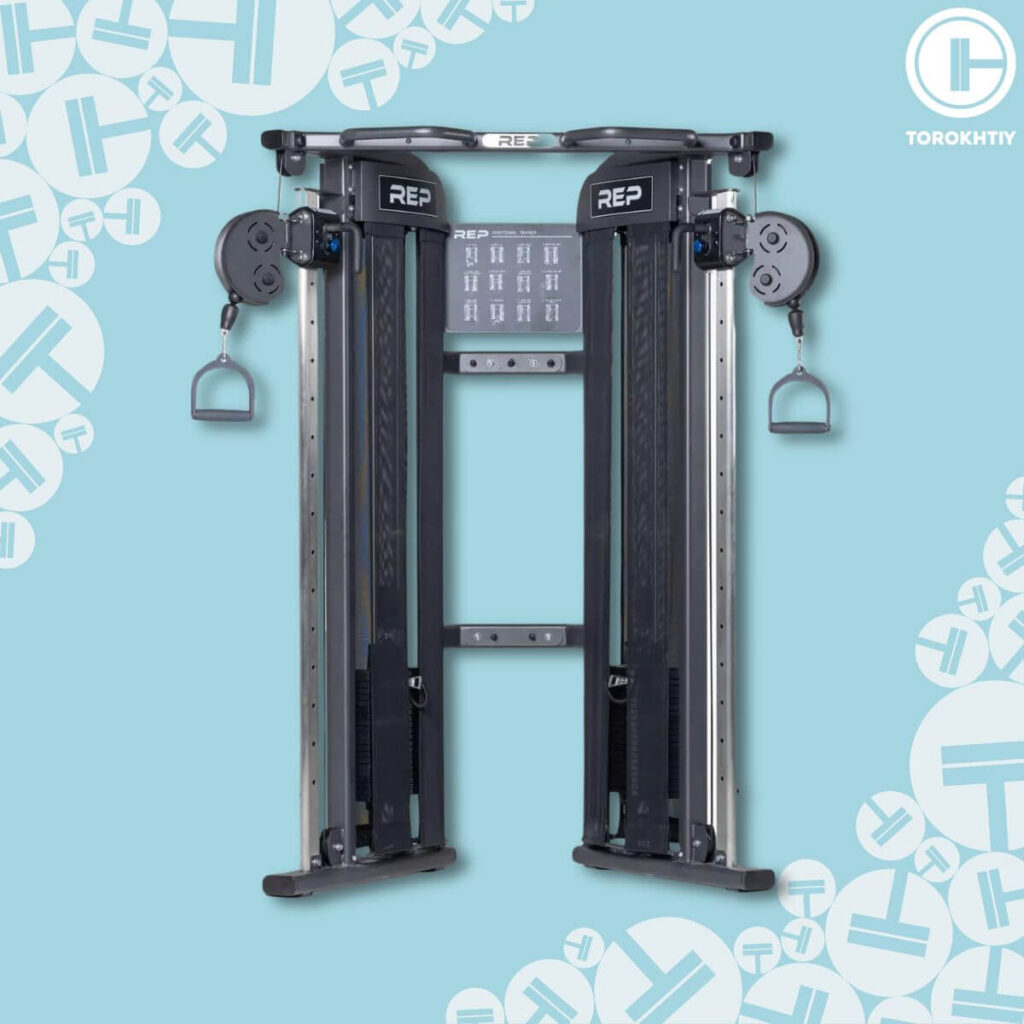


Still have questions after reading our article? Unlock your full potential by engaging with our experts and community! Don’t hesitate — leave a comment below and Ihor Shymechko will provide a personalized answer and insights to help you reach your goals.